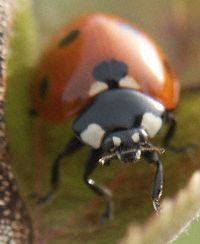Lady Beetles
We're all accustomed to the Elizabethan image of little girls in golden pig-tails holding gentle red ladybugs on their fingers. Well, maybe not all of us, but the image seems valid.
Certainly most of us have held ladybugs as youngsters, or presented them with a smile to young wide-eyed relatives. They're an innocuous group of our world.
That is, they used to be an innocuous group in our world. If you went outside in the Fall of 2001, you noticed that ladybugs were everywhere. On windows and walls, under eaves and trees, in the air and even your hair, ladybugs are suddenly everywhere. And when the cold set in, you may have found them congregating inside your house.
This phenomena led me to research this ladybug thing. You never know—this could have been a misfired attack on America.
It turns out that ladybugs are not bugs after all. They're beetles, and the proper reference to the creatures is lady beetles. And despite the name, half of the species is male.
Looking deeper into the issue, (meaning digging around for an hour online at all the university entomology websites) you find out that ladybugs—er, lady beetles, are not exactly the innocent concoctions of mobile, black-spotted red dots we have always thought.
They're largely carnivores. That means they eat other creatures. Mostly aphids, it turns out, which is a good thing. Aphids are pests that devour beneficial vegetation. This has led them to be labeled in the agricultural industry as a "beneficial insect." Still, the images of innocent little girls holding ladybugs aren't the same when you have seen the insects voraciously devouring other insects.
Cornell University reports that there are over 450 species of ladybugs in North America. On it's biological control site, Cornell says, "The convergent lady beetle may eat its weight in aphids every day as a larva and consume as many as 50 aphids per day as an adult. Sevenspotted lady beetle adults may consume several hundred aphids per day and each larva eats 200 to 300 aphids as it grows. Once the adults and larvae have eliminated an aphid colony, they will search for additional food."
Lady beetles are often introduced into environments as pest control. One of the increasingly prominent species is the Multicolored Asian Lady Beetle (MALB), which originated in Japan. This insect has increased its range dramatically since it was first introduced in the early 1900s. During the 60s, 70s and 80s many states intentionally introduced the bug to help control pest insects.
The problem has been that the lady beetles have started using homes as congregation and hibernation sites. Ohioline News from OSU reported that a woman in Hocking County collected 11,000 lady beetles from her home over two days in 2001.
The insects (generally) won't bite. However, that isn’t always the case. In the September 2003 newsletter published by the Ohio State University Integrated Pest Management Program, experts noted that most published fact sheets about MALBs stated that the lady beetle does not bit—a fact that OSU contradicts. OSU researchers conclude that 30 percent of overwintering populations bite. "If these beetles break the skin and are allowed to continue, they will feed on the wound for as long as 30 minutes!"
From what I gathered online, they don't carry disease. And since they eat pests, ladybugs are pretty fine creatures. Still, you might want to wear something that goes good with black and red for the next fall season so you won't clash with your surroundings—you can make a good bet that the lady beetles will be back next year, and they could easily be more prominent than ever.
- Beetles
Articles and photos regarding beetles.
- Locust Borer
- Grapevine Beetle
- Lady Beetles
- Tiger Beetle - Ohio
- Beetles
- Related Topics












